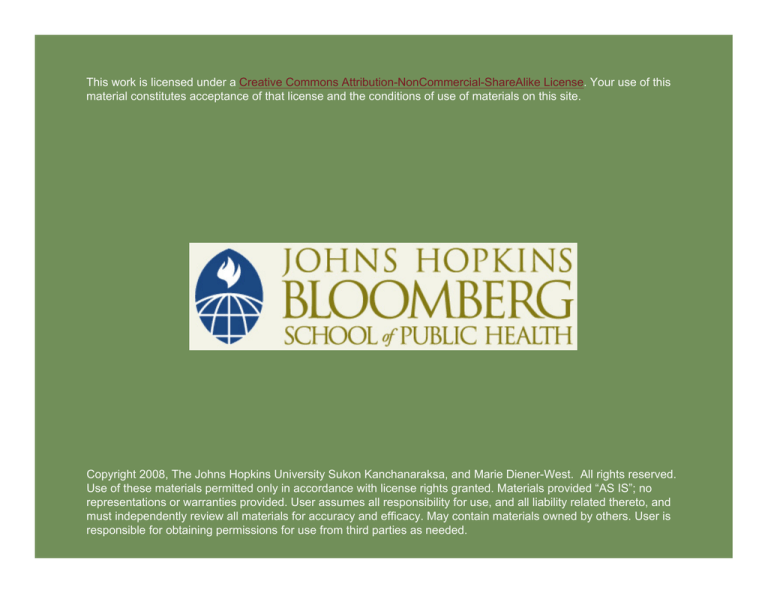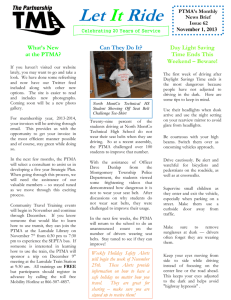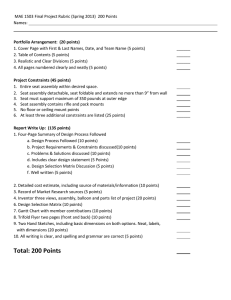
This work is licensed under a Creative Commons Attribution-NonCommercial-ShareAlike License. Your use of this
material constitutes acceptance of that license and the conditions of use of materials on this site.
Copyright 2008, The Johns Hopkins University Sukon Kanchanaraksa, and Marie Diener-West. All rights reserved.
Use of these materials permitted only in accordance with license rights granted. Materials provided “AS IS”; no
representations or warranties provided. User assumes all responsibility for use, and all liability related thereto, and
must independently review all materials for accuracy and efficacy. May contain materials owned by others. User is
responsible for obtaining permissions for use from third parties as needed.
Biostatistics and Epidemiology within
the Paradigm of Public Health
Sukon Kanchanaraksa, PhD
Marie Diener-West, PhD
Johns Hopkins University
Section A
Biostatistics and Epidemiology within
the Paradigm of Public Health
Steps in the Paradigm of Public Health
Define the problem
Measure its magnitude
Understand the key determinants
Develop intervention/prevention strategies
Set policy/priorities
Implement and evaluate
4
Quantitative Methods
Epidemiology and biostatistics are the basic sciences of
public health
Public health investigations use quantitative methods,
which combine the two disciplines of epidemiology and
biostatistics
Epidemiology is about the understanding of disease
development and the methods used to uncover the etiology,
progression, and treatment of the disease
Information (data) is collected to investigate a question
The methods and tools of biostatistics are used to analyze the
data to aid decision making
5
Epidemiology
Epidemiology is the study of the distribution and
determinants of health, disease, or injury in human
populations and the application of this study to the control of
health problems
− Examples
X National and local surveillance system (cancer, AIDS,
occurrence of E. coli O157:H7 outbreak)
X Cohort study to investigate the association of cell
phone use and the development of brain tumors
X Survey of individuals who took Cox-2 inhibitors
6
Biostatistics
Statistics is the science and art of dealing with variation of
data in order to obtain reliable results and conclusions
Biostatistics is the application of statistics to problems in the
biological sciences, health, and medicine
− Examples
X Computing age-adjusted cancer incidence rates to
determine trends over time and locality
X Calculating statistical measures of the risk of
developing brain tumors following cell phone use
after adjusting for possible confounding variables
X Quantifying the relationship between use of Cox-2
inhibitors and quality of life
7
Role of Quantitative Methods in Public Health
1. Address a public health question
− Generate a hypothesis
X Based on scientific rationale
X Based on observations or anecdotal evidence
(not scientifically tested)
X Based on results of prior studies
− Examples of a hypothesis
X The risk of developing lung cancer remains constant
in the last five years
X The use of a cell phone is associated with developing
brain tumor
X Vioxx increases the risk of heart disease
8
Role of Quantitative Methods in Public Health
2. Conduct a study
− Survey study is used to estimate the extent of the
disease in the population
− Surveillance study is designed to monitor or detect
specific diseases
− Observational studies investigate association between
an exposure and a disease outcome
X They rely on “natural” allocation of individuals to
exposed or non-exposed groups
− Experimental studies also investigate the association
between an exposure, often therapeutic treatment, and
disease outcome
X Individuals are “intentionally” placed into the
treatment groups by the investigators
9
Role of Quantitative Methods in Public Health
3. Collect data
− Numerical facts, measurements, or observations obtained
from an investigation to answer a question
− Influences of temporal and seasonal trends on the
reliability and accuracy of data
− Examples
X The number of lung cancer cases from 1960–2000 in
the United States
X The number of deaths from cardiovascular diseases
in Whites and African Americans from 2000–2004
X The number of people with heart attacks among
individuals having used Vioxx before 2004
10
Role of Quantitative Methods in Public Health
4. Describe the observations/data
− Descriptive statistical methods provide an exploratory
assessment of the data from a study
X Exploratory data analysis techniques
X Organization and summarization of data
− Tables
− Graphs
− Summary measures
11
Role of Quantitative Methods in Public Health
5. Assess the strength of evidence for/against a hypothesis;
evaluate the data
− Inferential statistical methods provide a confirmatory
data analysis
X Generalize conclusions from data from part of a
group (sample) to the whole group (population)
X Assess the strength of the evidence
X Make comparisons
X Make predictions
X Ask more questions; suggest future research
12
Role of Quantitative Methods in Public Health
6. Recommend interventions or preventive programs
− The study results will prove or disprove the hypothesis, or
sometimes fall into a grey area of “unsure”
− The study results appear in a peer-review publication
and/or are disseminated to the public by other means
− As a consequence, the policy or action can range from
developing specific regulatory programs to general
personal behavioral changes
13
Six Examples
Examples of how quantitative methods are useful in
addressing public health problems
14
Probability of Breast Cancer?
The National Cancer Institute estimates that women have an
average lifetime risk of 13.2 percent (often expressed as “1 in
8”) of being diagnosed with breast cancer at some time in
their lives
The chance that a woman will never develop breast cancer is
86.8 percent (expressed as “7 in 8”)
What is a probability?
Suppose there are two women working in the same office
− What is the chance (probability) that both women
develop breast cancer over their lifetimes?
Source:
http://www.cancer.org/docroot/CRI/content/CRI_2_4_1X_What_are_the_key_statistics_for_breast_cancer_5.a
sp?sitearea=
15
Relative Risk of Breast Cancer?
Having one first-degree relative (mother, sister, or daughter)
with breast cancer approximately doubles a woman’s risk of
developing breast cancer (as compared to women having no
first-degree relatives with breast cancer)
Having two first-degree relatives increases her risk fivefold
What is the probability or “risk”?
What is the “relative risk”?
Source:
http://www.cancer.org/docroot/CRI/content/CRI_2_4_1X_What_are_the_key_statistics_for_breast_cancer_5.as
p?sitearea
16
Comparison of Mortality Rates?
Johns Hopkins University is in the state of Maryland
− The death rate in Maryland was about 805/100,000 in
2002
Disney World is in the state of Florida
− The death rate in Florida was about 1,004/100,000 in 2002
Does the higher death rate in Florida mean that Florida is a
“riskier” place to live than Maryland?
What other factors must be considered?
Source: http://www.cdc.gov/nchs/data/nvsr/nvsr53/nvsr53_05.pdf
17
Chances and Family History
Does chance of having cancer depend on family history?
− You and your best friend just turn age 50
− During a routine visit to your doctor, you both had a PSA
blood test and both scores resulted in the same value of 5
ng/ml
− You have no family members with a history of prostate
cancer—but your best friend has a family history
Given the moderate PSA level, is the probability of having
prostate cancer the same for the two of you?
18
Findings from a Clinical Trial of Vioxx Treatment?
The drug Vioxx is effective in reducing pain
On September 30, 2004, Merck announced a worldwide
withdrawal of Vioxx from the market
A 12-week clinical trial study of Vioxx compared to Naproxene
in 5,500 patients was first published in 2003
− It reported that “five patients taking Vioxx had suffered
heart attacks during the trial, compared with one taking
naproxene, a difference that did not reach statistical
significance”
19
Findings from a Clinical Trial of Vioxx Treatment?
Subsequent follow-up by the FDA found that:
− “Eight people taking Vioxx suffered heart attacks
compared with one taking naproxene … The difference
was statistically significant …”
Can the addition of three deaths have such a great impact on
the finding?
What is the meaning of statistical versus clinical
significance?
20
Role of Quantitative Methods in Public Health
Address a public health question
Conduct a study
Collect data
Describe the observations/data
Assess strength of evidence for/against a hypothesis; evaluate
the data
Recommend interventions or preventive programs
21
Section B
Descriptive vs. Inferential Statistical Methods
Hypothesis and Study Design
Hypothesis: seat belts save lives
Study design: cross-sectional study of fatality outcome and
seat-belt use of victims of motor vehicle accidents during a
one-month time period in a large city
23
Description: Effect of Seat Belt Use on Accident Fatality
Seat Belt
Driver
Dead
Alive
Total
Fatality rate
Worn
Not Worn
10
40
50
10/50 (20%)
20
30
50
20/50 (40%)
24
Your Conclusion?
What is your conclusion?
− The fatality rate is:
X 40% in the group of drivers who did not wear seat
belts
X 20% in drivers who did wear seat belts
− Seat belts appear to save lives
25
The Inferential Questions of Interest
The inferential questions of interest are:
− Are results applicable to the population of all drivers?
(generalization)
− Does wearing seat belts save lives? (assess strength of
evidence)
Is the fatality rate of those not wearing seat belts higher than
the fatality rate of those wearing seat belts? (comparison)
How many lives can be saved by wearing seat belts?
(prediction)
Do other variables influence the conclusion?
− For example: the age of driver, alcohol use, type of car,
speed at impact (ask more questions)
26
Speed at Impact
Speed at Impact
<= 30 Miles per Hour
Driver
Dead
Alive
Total
Fatality rate
Seat Belt Seat Belt
Worn
Not Worn
3
27
30
10%
2
18
20
10%
> 30 Miles per Hour
Seat Belt
Worn
Seat Belt
Not Worn
7
13
20
35%
18
12
30
60%
27
How Does This Influence Your Conclusion?
How does this influence your conclusion?
− The fatality rate is 10% at low-impact speeds regardless of
seat-belt use
− The fatality rate at high impact speeds is:
X 60% in drivers not wearing seat belts
X 35% in drivers wearing seat belts
28







